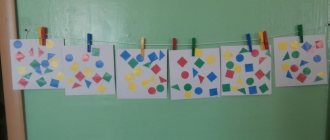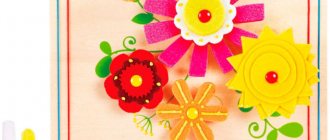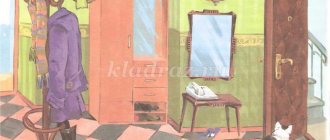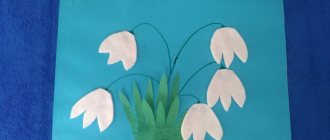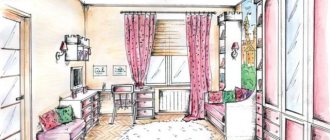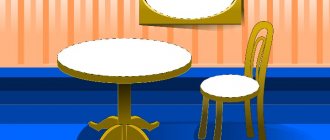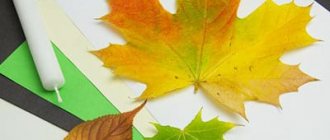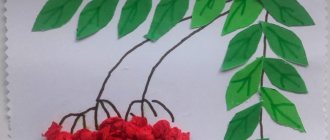Striped furniture
Applique:
Striped furniture.
To consolidate children’s knowledge on the topic “Furniture”, to activate the vocabulary on this topic;
Develop children's creativity and imagination;
Foster independence and activity;
Reinforce techniques for careful use of glue;
Learn to compose an image from strips of different lengths, following a certain sequence; place it correctly on the sheet;
Materials:
strips (10 cm and 5 cm * 11.5 cm), flannelgraph, strips of velvet paper, glue, napkins, maples, brushes.
1h
. Creating a game situation.
Reading the fairy tale “The Three Bears.” Remember the fairy tale “The Three Bears” with your children. Find out what Mashenka broke.
Show the children the stripes (one long, one short, for each child) and say that such stripes remain after the application and should be thrown away. But one day the stripes “revolted” and said that they could also be useful: “We can make different furniture,” they said.
Conversation with children about furniture. Find out what kind of furniture can be made from such strips.
You can sleep on the bed,
Chairs, table - rearrange.
I will put books in the closet,
I will cover the chairs.
Invite the children to draw an image of a table or bed on a flannelgraph. The teacher accompanies the drawing of the image with a comment, while naming the parts of the furniture: table top, legs, back, etc.
When laying out an image on a flannelgraph, the teacher asks the children to lay out the same image on sheets of paper.
We slept on the bed
Things have already been put away in the closet.
We sat on a chair
And we ate at the table.
3h
. Independent work.
After the children have posted all the images, offer to stick on the piece of furniture they like and give it to the three bears in the hut. When doing the work, the teacher reminds you of the sequence of laying out: first you need to lay out the long strip, and then the short ones; about the correct location on the sheet - in the middle, about accuracy. When gluing, learn about the rules for working with glue.
Ask the children what they did? What is this or that furniture for? Name the parts.
Master class on the application “Table lamp”
This MK was created specifically for beginners. It can be carried out in kindergarten, and can also be performed by parents together with their children. We will need:
- sheets of colored paper (it is better to take shiny paper with a pattern);
- colored cardboard;
- scissors;
- stencils that must be pre-printed;
- glue.
The table lamp is made based on a template. Step-by-step instructions with a detailed description of all actions are given below:
- First, the lampshade is cut out - it will certainly have to be made of shiny paper in order for the lamp to turn out like a real one.
- The lamp stand is cut along the contour.
- All parts are glued onto a cardboard sheet.
- Next, design the applique - you can make a pattern on the base or stick on a pre-prepared design, for example, as shown in the photo.
Of course, you can and should make crafts based on different lamps - let there be many options so that every child can choose what he likes.
Advice! In the older group, you can complicate the applique and “put” the lamp on the table surface - to do this, you need to reduce it a little in size or take two sheets of cardboard to make the applique larger.
Preview:
Municipal autonomous preschool educational institution
"General developmental kindergarten No. 23"
Summary of the final lesson
“Artistic and aesthetic development” (application).
“Furniture for a bear” (second junior group)
Topic: "Furniture for the Bear."
Purpose: To consolidate the understanding of pieces of furniture and their purpose.
Continue to develop the ability to create a composition from ready-made parts.
Continue to develop creativity and imagination. Reinforce techniques for careful use.
Material: Presentation; magic umbrella; magnetic board with magnets; a bag with mugs (2 different colors); 4 large mugs of different colors; furniture samples; material for applique - circles, rectangles, squares; white paper for each child, glue, napkin, oilcloth.
Preliminary work: looking at the album: “Furniture”; conversation about furniture; drawing on the theme “Furniture”; reading the fairy tale “Masha and the Bear”; watching the cartoon "Masha and the Bear".
Integration of educational areas: Artistic and aesthetic development, cognitive development, speech development.
Cognitive development - to develop research skills; consolidate ideas about furniture.
Social and communicative development – create conditions for emotional responsiveness, readiness for joint activities with adults; cultivate a good attitude towards the game character, a desire to help him and the ability of children to listen to the teacher.
Speech development - create conditions for developing the ability to conduct a dialogue, answer the teacher’s questions, and solve a riddle; activate the vocabulary (table, chair, bed, closet, circle, square, triangle...)
Let's hold hands tightly,
And let's smile at each other.
Let's smile at our guests.
Educator: Guys, do you like magic?
Educator: Do you want to get into a fairy tale?
Educator :: To find out who we are going to, you need to guess the riddle.
“He lives in the thicket of the forest,
Progress of the lesson
Guys, guess the riddle
Everyone loves me very much
I'll tell you honestly.
After a working day,
How to sit well in... (Chair)
That's right, guys. And today we will make an appliqué of a beautiful chair . To do this, take colored cardboard and a chair template. Using a simple pencil, outline the template. Then let's check that we got everything right. Now you can take scissors and carefully cut out the chair.
Let's remember the rules for using scissors so as not to hurt anyone. Independent work of children.
Let's go to the store in the morning (walking in place)
We'll buy furniture there:
Tall cabinet (stand on toes, stretch arms up)
And a stool, (squat)
Bed - we will sleep on it softly (put folded palms under the left cheek)
Let’s buy a chair (a bent left palm is attached to the straight right palm to make a “chair”
)
And the table is big (they spread their arms to the sides)
And we’ll take you home (turn the steering wheel)
It's time to decorate our chairs. We have colored squares that we will cut into strips.
To do this, you need to take scissors in your right hand, and a square in your left hand and cut it into narrow strips of paper. To make the stripes different colors, children sitting at the same table can exchange cut out strips. Then advise the children to arrange the stripes in alternating colors and stick them on.
Independent work of children
The children begin to do their work. The teacher pays attention to accuracy when working with glue, recalls the techniques for careful gluing, monitors the children’s posture when working, and recalls the rules for working with scissors. Helps children who are not doing well.
- Guys, let's remember what we did today?
— Are you satisfied with your work?
Look what wonderful chairs we have made. Everyone did a great job. Well done to all of you!
Photo report of the creativity of middle group children together with their parents. Application using torn paper technique and mosaic application. Photo report of artistic creativity of the middle group of children and joint work of parents with children. Elena Vladimirova. One of the non-traditional types. Photo report “Butterfly application in the middle group” Purpose: To create conditions for working with paper, scissors and glue. Objectives: - Expand color perception; - Reinforce careful handling.
Calendar planning for the thematic week “Furniture” in the younger group December, week 2 Goals of the teacher’s activities: to broaden the horizons of children through acquaintance with the objective world, to form ideas in children.
Collective application “It’s Summer!” in the middle group It is in the summer that a child gets inspiration to create bright creations. In the summer, everything around us is as bright and contrasting as possible. Very. Summary of direct educational activity “Furniture” for children of the middle group Pedagogical intent: To cultivate respect for people’s work and respect for the man-made world. Cognitive development: Improve.
"Furniture". Summary of GCD on the surrounding world in the senior group Summary of a lesson on the surrounding world in the senior group on the topic “Furniture” Goal: to clarify and expand the vocabulary on the topic “furniture” Tasks: - to clarify.
Abstract of the educational activity "Furniture" in the senior group of compensating orientation Abstract of the educational activity in the senior group of compensating orientation on the topic: "Furniture" Main educational area "Speech development" Educational.
Summary of a lesson on speech development on the lexical topic “Furniture” with children of the middle group 4–5 years old. The summary of the lesson was compiled based on the methodology of O. S. Ushakova. Prepared and conducted by the teacher of MBDOU kindergarten No. 76, Ryazan, first. Lesson summary in the preparatory group "Furniture" Lesson summary in the preparatory group "Furniture" Elena Vladimirova. Goal: To reinforce the general concept of furniture in children. Objectives: Educational:.
Lesson summary on application on the topic “Furniture”
Olesya Biryukova
Lesson summary on application on the topic “Furniture”
Lesson summary on application on the topic “ Furniture ”
Topic: Furniture for the Bear .
Goal: Learn to cut strips of paper (about 3-5 cm, hold scissors correctly, use them correctly. Develop creativity, imagination. Foster independence and activity.
Reinforce techniques for careful use of paper and glue
Material: Strips of paper, A4 size white paper for gluing images (3-4 sheets for each child, scissors, glue, glue brush, napkin, oilcloth.
Application "Furniture" in the middle group
Elena Timoshenko
Application “Furniture” in the middle group
Application on the theme “ Furniture ” Middle group
Striped chair (Colored paper. Decorative applique )
Program content: continue to teach children how to hold scissors correctly, squeeze and unclench rings, and cut in a straight line.
Strengthen the ability to decorate an object with colored stripes, alternating them by color. Reinforce techniques for careful gluing.
Learn to negotiate with each other about the progress of work.
Cultivate kindness and care for animals.
Preliminary work. Reading works about furniture . Puzzles. Looking at illustrations on the topic “ Furniture ”
.
Handout. Cardboard rectangles 12x6 cm, squares of colored paper of different colors 6x6 cm, scissors, glue, rags, oilcloth linings, chair templates.
Similar chapters from other books
Topic of the week: “My Home”
Topic of the week: “My Home” Lesson 21. Building a house (Modeling from plasticine) Program content. To develop in children the ability to sculpt a house from rolled up columns, placing them on top of each other and firmly connecting them together. Strengthen the ability to use a stack. Develop
Topic of the week: “My Home”
Topic of the week: “My Home” Lesson 41–42. Houses of the Three Little Pigs (part 1–2) (Drawing with pastel crayons, sanguine, charcoal, wax crayons) Program content. Continue learning how to make illustrations for fairy tales. Develop the ability to arrange objects on a sheet of paper. Learn
Theme of the week: “Furniture”
Topic of the week: “Furniture” Lesson 11. Blanket for Vanyushka (Drawing with felt-tip pens) Program content. Teach children to decorate a rectangular object with colored stripes, alternating them by color. Learn to understand and analyze the content of the nursery rhyme. Cultivate benevolence
Topic of the week: “My Home”
Theme of the week “My Home” Lesson 21. Houses for nesting dolls (Drawing with colored pencils) Program content. Teach children to draw small and large objects consisting of a square and a triangle. Continue learning how to compose a plot composition. Cultivate responsive
Theme of the week: “Furniture”
Topic of the week: “Furniture” Lesson 11. Table and chair (Plasticine molding) Program content. Learn to cut elongated plasticine columns into pieces using a stack and attach them to cardboard, depicting pieces of furniture in the form of a bas-relief (the image protrudes above
Topic of the week: “My Home”
Theme of the week “My Home” Lesson 22. House for a bunny and a rooster (Plasticine modeling) Program content. Strengthen children's ability to bring a product to the desired image using plasticine. Learn to retell fairy tales based on illustrations. Demonstration material. Heroes
Topic of the week: “In the kitchen”
Theme of the week “In the kitchen” Lesson 17. Gzhel cup (Painting with gouache) Program content. Introduce children to Gzhel. Learn to highlight the characteristic features of Gzhel painting, decorate the border of a cup with simple elements of painting (straight and wavy lines of various
Topic of the week: “In the room”
Theme of the week “In the room” Lesson 19. Carpet (Decorative drawing with felt-tip pens) Program content. Learn to draw patterns on the carpet in the form of long, non-touching lines. To develop children's aesthetic perception, fantasy and imagination. Cultivate love for Russians

